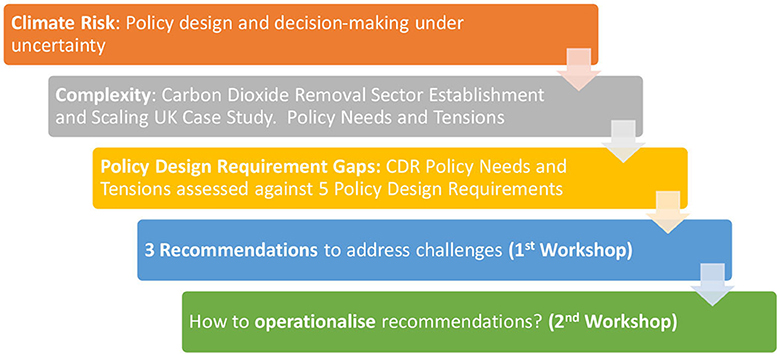Assessing climate ambition through policy outputs: a comparative measure of 35 major emitters – Nature

Report on National Climate Policy Ambition and its Alignment with Sustainable Development Goals
Executive Summary
This report provides a comparative analysis of national climate policy ambition, examining the efforts of 35 major emitters from 1990 to 2020. A new metric, the Climate Policy Ambition Index (CPAI), was developed to measure the depth and breadth of policy outputs, offering a crucial tool for monitoring progress towards Sustainable Development Goal 13 (Climate Action). Key findings indicate a significant global increase in climate ambition following the 2015 Paris Agreement, underscoring the influence of international frameworks as envisioned in SDG 17 (Partnerships for the Goals). However, the analysis reveals a critical and widening gap between stated policy ambition and actual performance in reducing emissions. While nations are formulating more policies, these are not translating into the substantive actions required to meet SDG targets. European countries consistently demonstrate higher ambition, but significant disparities exist globally and across different policy sectors, particularly in areas related to SDG 7 (Affordable and Clean Energy). The report concludes that stronger mechanisms are urgently needed to integrate ambitious climate policies into concrete implementation strategies, ensuring that national commitments effectively contribute to the 2030 Agenda for Sustainable Development.
1. Introduction: The Imperative for Climate Action within the SDG Framework
The 2015 Paris Agreement established a global framework for limiting temperature rise, operating in synergy with the 2030 Agenda for Sustainable Development. The success of this framework is intrinsically linked to achieving SDG 13 (Climate Action), which calls for urgent action to combat climate change and its impacts. This depends on nations progressively increasing their climate policy ambition and implementing effective actions. However, significant cross-national variations in ambition and a persistent gap between policy and performance hinder global progress. This report addresses this challenge by introducing a new comparative measure, the Climate Policy Ambition Index (CPAI), to systematically assess national climate policy outputs. By focusing on policy outputs—the direct expression of governmental intent—the CPAI provides a clear baseline to analyze the commitment to climate goals and identify the implementation gaps that threaten the achievement of the SDGs.
2. Methodology: Constructing the Climate Policy Ambition Index (CPAI)
The CPAI is an output-based index designed to provide a transparent and replicable measure of national climate ambition. It moves beyond simply counting policies to assess their substantive content, structured around two key dimensions:
- Breadth: The diversity of policy domains related to climate change.
- Depth: The intensity and stringency of the policy instruments employed.
The index tracks policy outputs across four key fields, each corresponding to critical SDGs, thereby providing a holistic view of national efforts.
2.1. Policy Fields (Breadth of Ambition)
The CPAI assesses policies across the following four areas, which are fundamental to a sustainable transition:
- Economy and Industry: Policies aimed at greening the economy, promoting sustainable industrial practices, and decoupling growth from emissions, directly supporting SDG 9 (Industry, Innovation, and Infrastructure) and SDG 12 (Responsible Consumption and Production).
- Energy Paradigm: Policies focused on transitioning to renewable energy sources and improving energy efficiency, which are central to achieving SDG 7 (Affordable and Clean Energy).
- Greenhouse Gas (GHG) Emissions: Direct regulatory policies and targets for emission reduction, forming the core of national efforts under SDG 13 (Climate Action).
- International Cooperation: National commitments to global climate agreements and frameworks, such as the UNFCCC and the Paris Agreement, reflecting a commitment to SDG 17 (Partnerships for the Goals).
2.2. Policy Instruments (Depth of Ambition)
Within each policy field, the CPAI measures the intensity of three types of instruments, based on the IPCC’s classification:
- Regulations and Standards (R&S): Mandates and legal requirements, such as emission limits or bans on certain technologies.
- Economic Incentives (EI): Market-based mechanisms like carbon taxes, emissions trading systems, and subsidies for green technology.
- Research and Development (R&D): Government investment in climate-related innovation and technology.
The index covers 35 major emitters from 1990-2020, analyzing 1,578 national-level public policy documents to generate its scores.
3. Key Findings: Trends in Global Climate Ambition
3.1. Evolving National Ambition and the Role of Global Partnerships (SDG 17)
The CPAI data reveals a distinct upward trend in global climate policy ambition, particularly after the adoption of the Paris Agreement in 2015. The average ambition level rose significantly, demonstrating the catalytic effect of international cooperation and the pledge-and-review mechanism on national policymaking. This highlights the effectiveness of global partnerships in driving domestic action, a core principle of SDG 17. However, regional disparities are stark:
- European Frontrunners: Countries like Germany, France, and the UK have consistently shown the highest levels of ambition.
- Improving Regions: Asian countries, including China, India, and Japan, showed marked improvements in their policy ambition between 2005 and 2016.
- Lagging Regions: Countries in the Middle East and North America demonstrated relatively little change, indicating an urgent need to enhance ambition to meet global climate goals.
3.2. Sectoral Divergence: An Imbalanced Approach to Sustainable Development
While overall ambition has increased, its depth varies significantly across policy fields. This divergence points to an imbalanced approach that could undermine the integrated nature of the SDGs.
- Economy and Industry (SDG 9 & 12): This sector shows a continuous and strong increase in ambition, reflecting a growing recognition of the economic opportunities in climate action and sustainable industrial transformation.
- Energy and Emissions (SDG 7 & 13): Progress in these critical areas has been modest. Nations appear to face greater difficulty in implementing quantified targets for emission cuts and energy system transformation, likely due to the high perceived costs and political challenges. This slow progress directly threatens the achievement of SDG 7 and SDG 13.
- International Cooperation (SDG 17): Ambition in this area is closely tied to key events in global climate negotiations, reflecting compliance with international milestones rather than continuous domestic policy enhancement.
3.3. The Widening Gap Between Ambition and Implementation
A comparison between the CPAI (measuring policy ambition) and the Climate Change Performance Index (CCPI), which includes performance outcomes, reveals a critical disconnect. While the median CPAI scores show a strong upward trend, CCPI scores have remained relatively stagnant. This indicates that the remarkable rise in policy ambition has not been matched by a corresponding improvement in real-world outcomes, such as emission reductions.
This growing “ambition-implementation gap” is the most concerning finding of this report. It suggests that the current international framework, while successful at elevating ambition, is failing to ensure that these ambitions translate into the transformative actions needed to achieve SDG 13. The logic of the Paris Agreement has promoted policy formulation but has not yet secured the necessary long-term socio-economic and technological shifts.
4. Discussion and Implications for the Sustainable Development Goals
This report makes a significant contribution by providing a structured, output-based tool—the CPAI—to assess national climate ambition. The findings carry profound implications for the 2030 Agenda.
- A Critical Threat to SDG 13: The widening gap between policy outputs and actual outcomes represents a fundamental challenge to achieving SDG 13. Celebrating increased ambition is premature if it does not lead to measurable progress.
- The Need for Integrated Policy (SDGs 7, 9, 12): The sectoral divergence in ambition highlights a fragmented approach. Greater emphasis must be placed on creating integrated strategies that link economic policy with robust targets for energy transition (SDG 7) and emissions reduction (SDG 13).
- Strengthening Implementation Mechanisms (SDG 17): The Paris Agreement has successfully fostered ambition but lacks sufficient mechanisms to enforce implementation. Future climate governance must focus on strengthening accountability, transparency, and support systems to help nations translate ambitious targets into concrete actions. This aligns with the call in SDG 17 to strengthen the means of implementation.
- Monitoring Progress: The CPAI can serve as a valuable tool for governments, civil society, and international organizations to monitor national commitments, identify policy gaps, and hold leaders accountable for aligning their climate strategies with their SDG pledges.
In conclusion, while the global community has made strides in elevating climate policy ambition, a critical disconnect from on-the-ground implementation threatens to derail progress on the Sustainable Development Goals. Closing this gap requires a renewed focus on robust, integrated, and actionable policies that move beyond rhetoric to deliver a sustainable and climate-resilient future for all.
SDGs Addressed or Connected to the Issues Highlighted in the Article
SDG 13: Climate Action
- The article is fundamentally centered on SDG 13, as it evaluates the “climate policy ambition” of 35 major emitters. Its primary focus is on national and international efforts to combat climate change and its impacts, directly referencing the Paris Agreement’s goal to limit global temperature rise. The text analyzes policies designed to “curb increased emissions” and assesses the effectiveness of global climate governance frameworks.
SDG 7: Affordable and Clean Energy
- The article addresses SDG 7 by analyzing national policies related to energy. It discusses how the “intensity levels across policies in the energy and emission fields increased modestly” and how countries struggle with “putting quantified targets for… energy transformation in place.” The developed Climate Policy Ambition Index (CPAI) explicitly measures policy outputs in the “energy paradigm,” which includes efforts towards renewable energy and energy efficiency.
SDG 17: Partnerships for the Goals
- SDG 17 is relevant due to the article’s strong emphasis on international cooperation as a driver for national climate policy. The analysis highlights the role of global agreements like the “UNFCC Convention, Kyoto Protocol, and Paris Agreement” in shaping national ambition. The article states that the “Paris logic has secured the rise of ambitions and promoted international climate cooperation,” underscoring the importance of global partnerships in achieving climate goals.
Specific SDG Targets Identified in the Article’s Content
SDG 13: Climate Action
-
Target 13.2: Integrate climate change measures into national policies, strategies and planning.
- The article’s core contribution, the Climate Policy Ambition Index (CPAI), is a tool designed to measure exactly this. It is described as a “comparative index of national climate policy ambition” that tracks “all types of public policy documents issued at the national level by the 35 countries.” This directly corresponds to the integration of climate measures into national policy frameworks.
SDG 7: Affordable and Clean Energy
-
Target 7.2: By 2030, increase substantially the share of renewable energy in the global energy mix.
- The article implies this target by assessing the “depth of ambition” in the energy sector. It notes that while ambition in economy-wide sectors has increased, the “intensity levels across policies in the energy… fields increased modestly.” This analysis of policy stringency regarding energy transformation is directly related to national efforts to increase renewable energy shares.
-
Target 7.a: By 2030, enhance international cooperation to facilitate access to clean energy research and technology… and promote investment in energy infrastructure and clean energy technology.
- This target is addressed through the article’s inclusion of “research and development (R&D)” as a key policy instrument measured by the CPAI. The framework identifies R&D as one of “three general types of national policy instruments,” indicating that national ambition is partly measured by investment and focus on new technologies.
SDG 17: Partnerships for the Goals
-
Target 17.14: Enhance policy coherence for sustainable development.
- The article directly analyzes policy coherence by investigating the “growing gaps between ambition and outcomes.” It does this by comparing the CPAI (measuring policy outputs/ambition) with the Climate Change Performance Index (CCPI) (measuring outcomes). The finding of an “increasingly widening gap” highlights a lack of coherence between stated policy goals and their actual implementation, a central concern of this target.
-
Target 17.16: Enhance the global partnership for sustainable development, complemented by multi-stakeholder partnerships that mobilize and share knowledge, expertise, technology and financial resources…
- The article evaluates the effectiveness of the Paris Agreement, a primary global partnership for climate action. It measures countries’ commitment to this partnership through indicators in the CPAI such as the “ratification of UNFCCC climate treaties” and the “submission of (Intended) NDCs,” which are direct results of this global framework.
Indicators Mentioned or Implied for Measuring Progress
For Target 13.2 (Integrate climate change measures)
- Existence and Stringency of National Climate Policies: The article’s primary indicator is the Climate Policy Ambition Index (CPAI) itself, which is an aggregation of scores from 12 policy variables. Specific components mentioned that serve as indicators include the “submission of (Intended) NDCs,” the existence of “national climate strategies,” and the establishment of “quantified targets for emission mitigation.”
For Target 7.2 (Increase renewable energy share)
- Intensity of National Energy Policies: The article does not measure the actual share of renewables (an outcome) but focuses on policy outputs. The CPAI measures the “intensity levels of climate policy outputs… across policy fields,” including the energy sector. This serves as an implied indicator of a country’s commitment to transforming its energy system.
For Target 17.14 (Enhance policy coherence)
- The Gap Between Policy Ambition and Policy Performance: The article explicitly proposes and measures this indicator by comparing the trend of its CPAI with the trend of the CCPI. The text states, “the limited outcomes alongside the high rise of ambition reveal an increasingly widening gap,” which serves as a direct, quantifiable indicator of the lack of policy coherence.
For Target 17.16 (Enhance global partnership)
- Participation in and Commitment to International Climate Agreements: The article uses several indicators to measure this, which are part of the CPAI. These include the formal “ratification of UNFCCC climate treaties” (Kyoto Protocol and Paris Agreement) and the declaration of a “carbon neutrality target,” which demonstrates a country’s alignment with the goals of the global partnership.
Table of SDGs, Targets, and Indicators
| SDGs | Targets | Indicators Identified in the Article |
|---|---|---|
| SDG 13: Climate Action | Target 13.2: Integrate climate change measures into national policies, strategies and planning. | The Climate Policy Ambition Index (CPAI) and its components, such as the submission of Nationally Determined Contributions (NDCs), establishment of national climate strategies, and quantified emission reduction targets. |
| SDG 7: Affordable and Clean Energy | Target 7.2: Increase substantially the share of renewable energy in the global energy mix.
Target 7.a: Enhance international cooperation to facilitate access to clean energy research and technology. |
The measured intensity of policies in the energy sector, including those for energy transformation.
The measured intensity of national policies for research and development (R&D) as a component of the CPAI. |
| SDG 17: Partnerships for the Goals | Target 17.14: Enhance policy coherence for sustainable development.
Target 17.16: Enhance the global partnership for sustainable development. |
The measured divergence between the CPAI (policy ambition) and the CCPI (policy performance), described as the “gap between ambition and outcomes.”
National participation in international climate agreements, measured by the ratification of the Kyoto Protocol and Paris Agreement, and the submission of NDCs. |
Source: nature.com

What is Your Reaction?
 Like
0
Like
0
 Dislike
0
Dislike
0
 Love
0
Love
0
 Funny
0
Funny
0
 Angry
0
Angry
0
 Sad
0
Sad
0
 Wow
0
Wow
0































_1.png?#)













































